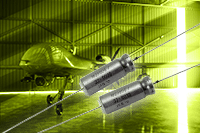source: Vishay news
MALVERN, Pa. — Feb 9, 2017 — Vishay Intertechnology, Inc. (NYSE: VSH) today announced that it has expanded the capacitance range of its M39006/33 (Style CLR93) tantalum-cased, hermetically sealed wet tantalum capacitor. Offering established reliability for critical avionics and aerospace systems, the device is the industry’s first such capacitor qualified to the MIL-PRF-39006/33 specification to offer capacitance from 15 µF to 680 µF over a wide voltage range from 50 V to 100 V.
The extended Vishay Sprague capacitor released today combines its high capacitance and established reliability with excellent reverse voltage, vibration, and thermal shock performance. Optimized for timing, filtering, energy hold-up, and pulse power applications in power supplies for space and avionics equipment, the device allows designers to incorporate fewer capacitors into these products to lower overall system costs.
Offered in the axial T1, T2, T3, and T4 case sizes, the M39006/33 features capacitance tolerance of ± 10 % and ± 20 % standard and maximum ripple current of 2750 mA. The device operates over a temperature range of -55 °C to +85 °C, to +125 °C with voltage derating.
Samples and production quantities of the extended M39006/33 capacitor are available now, with lead times of 10 weeks for large orders.






























